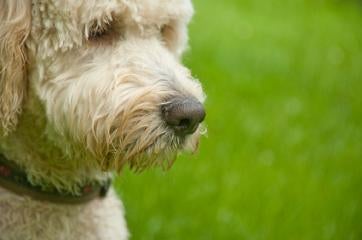Labradoodle Breed Information & Training Advice
Throughout history, people have been breeding dogs to serve a specific purpose, or to have a particular set of characteristics. For example, working breeds were developed to have intelligence, stamina and a strong herding instinct. Hounds needed to have a particularly well developed sense of smell so they could follow a scent.
If you look at the origins of many of the pure breeds of dogs, you'll find they are in fact a combination of two or more breeds, in the hope that the best characteristics of each breed would appear in the offspring. The pups of that combination are then carefully bred together until the characteristics of the new breed are very consistent. They could then be recognized as a new breed.
These days, a cross between two pure breeds of dogs is called a "designer dog", and is often frowned upon by fanciers of purebred dogs.

The Labradoodle is a cross between two beautiful breeds, the Labrador Retriever and a Poodle. These breeds were chosen to produce an intelligent trainable dog which was less likely to shed hair and cause reactions in allergic people. Unfortunately, there's no guarantee that a Labradoodle won't cause an allergic reaction. People can be allergic to dog saliva or skin scurf as well as dog hair, so they may still react to the Labradoodle coat.
Labradoodle History
The first litter of Labradoodles was bred in Australia in 1989 by Wally Conron, who worked with the Royal Guide Dogs Association in Victoria. He had been asked to try to breed a guide dog for Mrs Pat Blum, whose husband was allergic to dogs. Labrador Retrievers were already well known as guide dogs, so he crossed a Labrador Retriever with a Standard Poodle. He hoped that the resulting dogs would have the Poodle's non shedding coat, and cause less problems for people allergic to dogs.That first breeding resulted in three pups. Of the three, only one had a coat that didn't cause an allergic reaction, and he was successfully trained as a guide dog for Mrs Blum.
Crossing the Labrador Retriever with a Poodle produced attractive pups with a great temperament who were easy to train. Unfortunately, this meant that people were crossing any Labrador Retriever with any Poodle, to take advantage of the increased demand. This led to a wide variation in the breed's appearance, as well as an increase in the occurrence of genetic conditions such as hip dysplasia and eye disease.
Over the years, breeders have at times introduced other breeds including Cocker Spaniels, American Cocker Spaniels and the Irish Water Spaniel to the mix, to improve certain characteristics of the Labradoodle. They also started testing for genetic diseases, to make sure their puppies were as healthy as possible.
Breeding designer dogs has a language all of its own, which can at times be confusing. The pups born to a Labrador Retriever crossed with a Poodle are known as the F1 generation. Two F1 dogs can then be crossed to produce F2 dogs. Alternatively, a F1 pup can be bred back to a Poodle to produce dogs known as F1b (b for back cross) dogs. These dogs are the most likely to be hypoallergenic.
At this point, it's important to differentiate between the Labradoodle, and the Australian Labradoodle. Many people use the terms interchangeably, but strictly speaking, the Labradoodle is a crossbreed dog, resulting from the mating of a Labrador Retriever to a Poodle. Breeders may also cross a F2 dog to an F5 dog, for example, or a Labradoodle back to one of the parent breeds, to create what's called a multi generational Labradoodle. Because they can have characteristics of either parent, their coat type can vary and their adult size may be unpredictable.
The Australian Labradoodle is being developed in Australia with the aim of having it recognized by the Australian National Kennel Council and other regulatory bodies worldwide. The Australian Labradoodle results from breeding two F1 dogs to produce F2 dogs, then breeding these F2 dogs to produce F3 pups. This is continued until you have F6 dogs, and at this stage, the dog is considered to be a "purebred". Their characteristics are very consistent, so you can confidently predict the appearance and temperament of the offspring.

Labradoodle Size & Appearance
With their long hair and toothy grin, Labradoodles are a delightful looking dog, and come in a variety of sizes, coat types and colors.Because the Labrador Retriever can be bred to either a Standard Poodle or a Miniature Poodle, there are three sizes of Labradoodle; the standard dog is 21-24 inches at the withers, the medium dog is 17-20 inches, and the mini dog is 14-16 inches.
Their coat is usually 4-6 inches long and again, comes in three types. The fleece coat is soft and silky, whereas the wool coat has a soft curl like the Poodle. Finally, the hair coat can be straight or wavy, and has a similar texture to the Labrador coat. As we've already mentioned, there's no guarantee that the coat won't cause an allergic reaction in a sensitive person, and it's also not a given that they'll have a non-shedding coat.
If you're starting to think there's a Labradoodle to suit everybody's tastes, you're right, and it gets better! Labradoodles come in the same range of colors as the Poodles. Red, gold, white, chocolate, black, silver and apricot are all common colors in the breed.
Labradoodle Temperament / Characteristics
Labradoodles have the perfect temperament. They are playful, sociable and not at all aggressive. Naturally extroverted, they love being with people, and don't take well to being left alone for long periods. They are intelligent, and if they aren't encouraged to use their brain in positive ways, they'll become bored and get up to mischief.They're like both their parent breeds in that they love water, and are strong swimmers.
Labradoodles like a moderate amount of exercise, so they do need regular walks. They also have an athletic build, and do well at dog sports such as agility.
They're not exactly low maintenance. Depending on the coat type, they can take quite some time to brush. They often develop mats in their coat which need to be brushed or cut out. They may need the hair around their eyes and on their feet trimmed, and it helps with hygiene to trim the hair under the tail.
Alternatively, if you don't want to spend much time on grooming, you can clip them short all over, and just let the hair grow out.
While many breeders will describe the bred as non-shedding, this isn't true. The more poodle there is in the mix, the less shedding there is, but it's very likely you'll still have to vacuum dog hair off your carpet.
Many Labradoodle owners describe the breed as "goofy" or "bouncy". This may mean you need to take care if you have small children around your dog. They're not likely to bite them, but they may well bowl them over.
Labradoodle Health Care
Labradoodles have a lifespan of around 12 years and are, for the most part, a healthy breed. They may be prone to skin and ear complaints, and can have similar genetic disorders to those found in the parent breeds.There are several genetic diseases that can occur in the Labradoodle.
Both Poodles and Labrador Retrievers suffer from hip dysplasia. The hip is a ball and socket joint, and in this condition, either the ball or the socket is abnormal, and they don't fit together properly. This can cause hip arthritis and lameness. Treatment can involve long term pain relief medication or expensive surgery, so it's much better if it can be prevented.
Responsible Labradoodle breeders will take x-rays of the hips of their adult dogs before they are bred, and only breed dogs who have normal hips. This helps, but doesn't guarantee that the resulting litter will have good hip joints.
Both parent breeds can also have elbow dysplasia and again, x-raying the parents before breeding them gives the best chance of avoiding this affecting the pups.
Labradoodles can also have a genetic condition called Progressive Retinal Atrophy (PRA). This disorder causes the cells in the retina at the back of the eye to degenerate. There is no cure for PRA; affected dogs will eventually lose their vision. When you look for a Labradoodle to join your family, ask the breeder if the parents have been DNA tested for PRA, to avoid the heartache of your dog going blind.
Another genetic disorder, although very uncommon, is difficult to prevent. Addison's Disease is a hormonal condition which appears to be genetic in Poodles and Poodle mixes. In this disease, the body doesn't produce enough of the hormone cortisol. The symptoms are very vague, and may come and go over time. Dogs are a bit listless and trembly, they may be off their food, and often appear depressed. They may also drink lots of water, and have signs of an upset stomach such as vomiting. It's not usually diagnosed until a dog has a sudden episode of collapse and shock. Fortunately, once they're diagnosed, dogs with Addison's Disease can take medication and live a normal life.
The difficulty in preventing Addison's Disease is that it doesn't usually show up until a dog is at least four years old. By this time, most breeding dogs will have had one or more litter of pups. There's no screening test for the disease, so breeders can't test their dogs before they breed them. Until DNA testing for the disease is available, there's no guarantee that any Poodle or Poodle mix isn't going to be affected by the condition.
Training Your Labradoodle
Both the Labrador Retriever and the Poodle are very clever dogs who are quick to learn. It comes as no surprise that the Labradoodle is also a smart dog.Because of this, Labradoodles have been successfully trained as guide dogs, and as assistance dogs for disabled people.
This intelligence also makes them easy to train for the pet owner. To get the best out of your Labradoodle, take him to puppy classes from a young age for socialization and to learn basic manners. As he matures, he'll enjoy more advanced training classes. Intelligent dogs get up to mischief when they're bored, so encouraging him to use his brain will mean you'll have a much happier Labradoodle.
You may want to consider having a go at dog sports such as agility and flyball. Labradoodles are a natural at both, and they're great fun for both you and your dog.
Overview Of The Magnificent Labradoodle
The Labradoodle is an ideal family dog. Loyal, friendly and great fun to own, there are really no negatives to the breed. It's so important that you do your homework when choosing your puppy, to avoid any genetic conditions developing in your dog. A responsible and reputable Labradoodle puppy breeder is an invaluable ally in this process.Providing you're happy to take care of its coat, and spend the time to train this intelligent dog to fit into your family, your Labradoodle will provide you with many years of joy and companionship.
If you're ready to bring a new puppy into your life and you are considering a Labradoodle, I think you'd be making a great decision.
Some other pages you may be interested in:
Teach you dog all the basic obedience training commands.
Why do I like clicker dog training so much?
Learn how to clean your dog's teeth - it's crucial to your dog's health and wellbeing!
Go from Labradoodle Breed Information to Dog Training home page.
Please consult the services of a Professional Dog Trainer, Behaviorist or Veterinarian before implementing any of the advice contained on this site.











 Your Privacy Choices
Your Privacy Choices